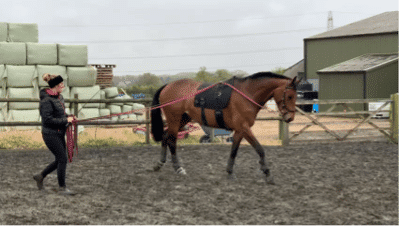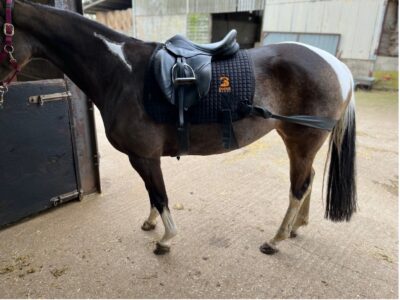Training, Training Aids, Training and Management
Training aids: resistance bands
Chloe Mabbutt guides us through when, why and how to use core and hind-quarter resistance bands
Resistance band systems have become increasingly popular over recent years, with their focus on core strength and hindlimb engagement¹ appealing to horse owners to improve way of going and to reduce back pain. The biggest difficulty with ascertaining their effectiveness is the material and quality of the bands, alongside HOW they are being used.
How are the meant to work?
The bands are decided to stimulate sensory receptors on the skin, alongside proprioceptors in the deeper underlying tissue, to activate the underlying musculature, such as the rectus abdominis. The way the horse’s musculoskeletal system works, means the back and core act as a bow and string system, you tighten the string (the core), this helps “bend and extend” the bow (the upper aspect of the back). And furthering on, due to the connection of the pelvis to the spine, and the underlying lumbar (lower back) muscles, simply engaging the core will engage the pelvis and create greater collection; the hindquarter band is simply able to enhance this effect. This correct posture assists with spinal stability and the transference of energy from the hindlimbs to the forelimbs allowing forward “pushing from behind, which is energy efficient².
Do they actually work?
Several studies have found resistance band use increases core (rectus abdominis) muscle use³, and improves thoraco-lumbar (back) stability⁴ ⁵ ⁶ when used on the lunge. This can be beneficial not only for “way of going” and improving performance, but for rehab of conditions such as kissing spines, where back stability and strength is vital. However only one such system has specifically been validated in its use, the Equiband system by Equicore concepts. Additionally, hindquarter muscle activation has not been measured, therefore it is not clear if the bands do condition the hindlimb musculature as also stated.
How to use

Key messages from manufacturers are that they should not “slip” during movement and, should have consistent contact during movement, with the tension spread equally from beginning to end (Rombach – Horse and Hound). Additionally, the core band is generally easy to fit, but the hind-quarter band should sit ideally level with the stifle joint (higher than pessoa ropes usually sit).
The bands can be used either just as the core band, just as the hindquarter band, or a combination of the two. I always recommend to my clients they start with just the core band, unless the horse is already well versed in using their core and the aid is just being placed on for additional strengthening purposes. This is because biomechanically the horse needs to be able to stretch over its back, and engage the core muscles, such as rectus abdominis, before you ask it to engage its pelvis, engaging muscles such as the iliopsoas complex, which originate from under the lumbar vertebrae. Therefore, the more the back is already flexed, the “looser” the iliopsoas starts, and the more collection can be obtained². Whereas if the horse is not engaging its core before you ask for collection, they will simply shift their weight backwards and, if the pelvis does try to rotate at the lumbosacral junction while the rest of the back is more extended, this will limit its flexion potential⁷.
Manufacturers/professionals⁸ ⁹ often say to start by measuring the distance from clip to clip, ie, under the belly for the belly band from clip to clip, and then setting the length of the band to 90%-70% of this length (i.e., starting at 10%-30% tension to check tolerance). Then using the band(s) for half your normal session length, before gradually over a couple of weeks, upping the tension (to max 50% for optimum use) and the time it is used for. As muscle takes around 6 weeks to build¹⁰, after this time you should then be able to start reducing its use once your horse is conditioned. However, there is no official “guidelines” on this, more professional experience! You can use during in-hand work, lunging and riding, but start in-hand for very weak horses.

What other exercises can you do instead?
This aid aims to ‘engage’ the core so, excercises based on that aim will be discussed.
As mentioned in a previous article, carrot stretches laterally, to the chest, and between the front legs are great for building topline muscle that stabilises the spine¹¹, increasing suppleness, and encouraging “rounding”. However, ensure you start easy, with nose to shoulder, before nose to flank! If the horse’s head “twists” during the movement, and their ears do not stay horizontal, you are going out of their range!
Belly lifts hypertrophy the multifidus (back muscle) creating spinal stability and preventing pain, and correct musculature recruitment for movement such as the epaxial and abdominal musculature¹¹ ¹². Pelvic tucks are a good exercise to engage the pelvis and encourage “rounding” of the lumbosacral joint. These should be performed by a therapist to start to ensure the horse is capable and for you to be shown correctly how to complete the exercise.
Walking up and downhill activates the hindlimb protractor muscles, such as vastus lateralis (quadriceps)¹³ ¹⁴, to aid braking forces and control, as-well-as recruitment of the longissimus dorsi (back muscle) and external abdominal obliques (core muscle) to create sagittal plane stabilisation and symmetry¹².
Murray et al.¹⁵ found walking over-ground and raised poles significantly increased wither/sacrum/tuber coxae mediolateral swing, thus suggesting an increase in paraspinal musculature activation and spinal mobilisation. However, with very weak backs or painful backs, this is not ideal, and stabilisation must be obtained before improving range of motion, therefore this may be where the resistance bands can provide support. Walking over poles may elicit more spinal movement, but trotting over poles increases core musculature through extensor, adductor and thoracic sling muscle recruitment¹⁶. Therefore, a combination of both methods should be employed for maximum benefit.
And finally, with ridden work/exercise, starting off simple, with shallow loops, serpentines, and other lateral bending exercises to create movement through the thoracic spine and therefore musculature stabilisation. More challenging exercises such as leg yielding in and out on a circle will encourage core engagement¹² as well as hindlimb collection on the smaller circles. Lunging can also create the same effect here, but be careful how much time is spent on a small circle.
As I’ve said before, work with a therapist and instructor to find your horse’s “starting point” and how to effectively progress, finding what works for them! Building a good foundation OFF the horse is key to a good foundation ON the horse.
Take home message
Take home message is, as mentioned in the previous article, that resistance bands should be an AID to training and should be used progressively. If using them, check they are not having a detrimental effect on your horse’s movement or, causing discomfort from incorrect fit, so watch the horse without the bands also and, mix up your training with other stable exercises and ridden ones. And finally, work with your vet, therapist and trainer to find the right methods for your horse!
References
1 Williams, J., 2020. Equine training aids: can they really improve performance? UK-Vet-Equine. 4(6):https://doi.org/10.12968/ukve.2020.4.6.196
2 Wagner, K., 2016. Equine Biomechanics and Locomotion. Keith Wagner Equine Veterinarian [online]. Available: https://wagnerhorsedoc.com/equine-biomechanics-locomotion/ [accessed 25/2/2022]
3 Shaw, K., et al. 2021. The Effect of Ground Poles and Elastic Resistance Bands on Longissimus Dorsi and Rectus Abdominus Muscle Activity During Equine Walk and Trot. Journal of Equine Veterinary Science. 107: https://doi.org/10.1016/j.jevs.2021.103772
4 Pfau, T., et al. 2017. Effect of a 4-week elastic resistance band training regimen on back kinematics in horses trotting in-hand and on the lunge. Equine Veterinary Journal. https://doi.org/10.1111/evj.12690
5 Simons, V., et al. 2015. Objective assessment of back kinematics and movement asymmetry in horses: effect of elastic resistance band training. Equine Veterinary Journal. 47(48): 11
6 Stenfeldt, P., et al. 2016. The effect of an elastic resistance band around the hindquarters on equine dorsoventral back kinematics. Acta Veterinaria Scandinavica. 58(2): A38
7 Wagner, K., 2016. Equine False Collection. Keith Wagner Equine Veterinarian [online]. Available: https://wagnerhorsedoc.com/equine-false-collection/ [accessed 14/4/2022]
8 Equicore Concepts, n.d. User Guide [online]. Available: https://equicoreconcepts.com/user-guide/ [accessed 14/4/22]
9 Equine Balance Bands, n.d. Quick Fit Guide [online]. Available: https://www.equinebalancebands.com/copy-of-fitting-and-adjusting [accessed 14/4/22]
10 Paulekas, R., and Haussler, K., 2009. Principles and Practice of Therapeutic Exercise for Horses. Journal of Equine Veterinary Science. 29(12): 870-893
11 Tabor, G., 2015. The effect of dynamic mobilisation exercises on the equine multifidus muscle and thoracic profile [thesis]. University of Plymouth. Accessed: http://hdl.handle.net/10026.1/3320
12 Clayton, H.M., 2016. Core training and rehabilitation in Horses. Veterinary Clinics of North America: Equine Practice.32(1): https://doi.org/10.1016/j.cveq.2015.12.009
13 Tabor, G., Williams, J., 2018. Equine Rehabilitation: A Review of Trunk and Hind Limb Muscle Activity and Exercise Selection. Journal of Equine Veterinary Science. 60: https://doi.org/10.1016/j.jevs.2017.03.003.
14 Crook, T.C., et al. 2010. The effect of treadmill speed and gradient on equine hindlimb muscle activity. Equine Veterinary Journal. 42: ://doi.org/10.1111/j.2042-3306.2010.00222.x
15 Murray, R., et al. 2020. Effect of walking over ground poles and raised poles compared to no poles on limb and back kinematics in horses with different postures. Equine Veterinary Journal 52: https://doi.org/10.1111/evj.10_13365
16 Clayton, H.M., et al. 2015. Stance phase kinematics and kinetics of horses trotting over poles. Equine Veterinary Journal. 47: https://doi.org/10.1111/evj.12251
